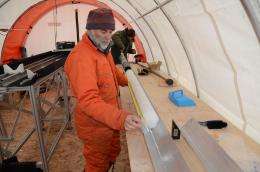Scientists successfully complete Antarctic drilling project

A new ice core successfully drilled from the Antarctica Peninsula last month (January) may shed new light on how the vulnerable West Antarctic Ice Sheet (WAIS) has responded to climate change in the past.
A seven-person team — a collaboration between British Antarctic Survey (BAS) and Laboratoire de Glaciologie et Géophysique de l’Environnement (LGGE) in France — has drilled a 650 metre ice core from Fletcher Promontory. The core will show how this part of Antarctica, bordering the WAIS nick-named as Antarctica’s ‘weak underbelly’, responded in the past. If the bottom of the core is as old as the last interglacial (130,000 years ago), then by comparing results with previous ice cores the team will investigate how the WAIS responded in the last interglacial (warm period) to better understand what may happen in the future.
Dr. Robert Mulvaney from BAS who led the project says, “This kind of project can take years to carry out so we are delighted that we managed to reach the bedrock in less than two months. It’s also very exciting to have reached the bedrock on the exact day 100 years ago that Captain Robert Falcon Scott reached the South Pole (17th January).”
In temperatures as low as −23°C, the team spent 35 days drilling the core including 21 days when the team drilled 24 hrs a day on shifts. The cores which are bagged in 1-metre long sections are currently being stored at BAS’ Rothera Research Station where they will stay until they can be shipped back to the UK and France later in the year for analysis.
Ice cores are unique climate records, allowing scientists to investigate climate changes over hundreds of thousands of years. The Earth's oldest ice is found in East Antarctica. The three oldest existing ice cores were drilled at Dome C, Dome F and Vostok. The longest ice core — at 3,650 metres — comes from Vostok, but the oldest ice core, drilled by the European Project for Ice Coring in Antarctica (EPICA) team, contains a climate record stretching back 800,000 years. Analysis of the ice cores has revolutionized our understanding of how Antarctic climate has varied in the past. Information from ice cores is vital for testing and improving the computer models used to predict future climate.
Interglacials recur roughly every 100,000 years between ice ages. The present warm period began around 10,000 years ago and has been relatively stable.
Provided by British Antarctic Survey



















